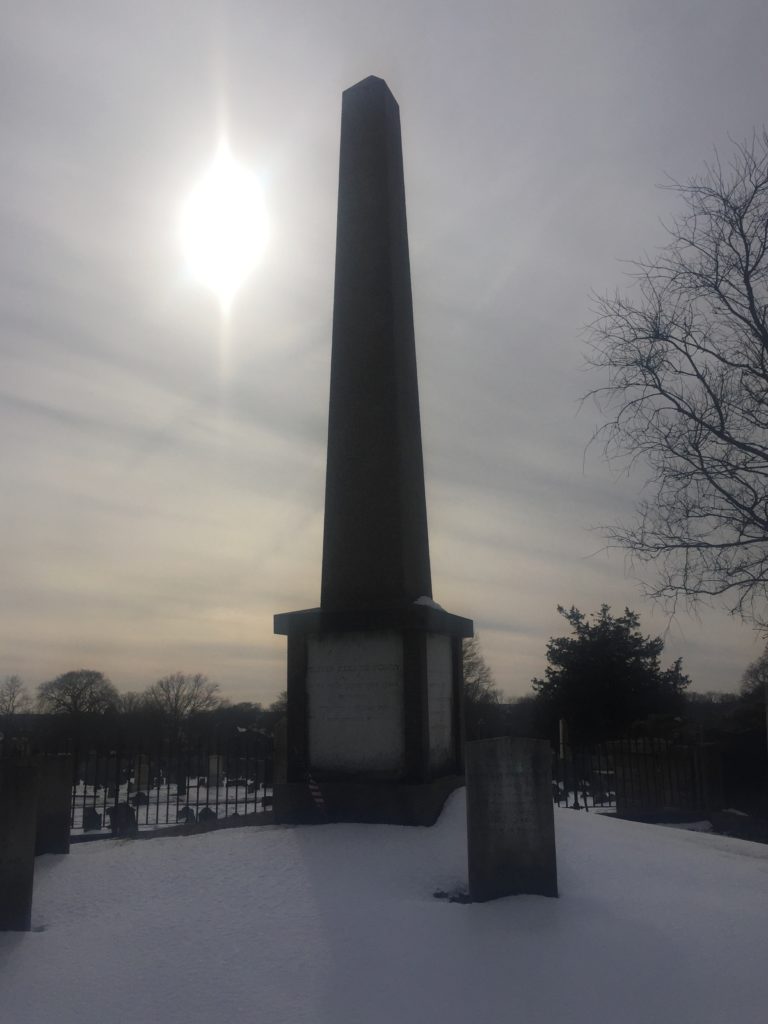Erik Visits an American Grave, Part 595
This is the grave of Oliver Hazard Perry.

Born in 1785 in South Kingstown, Rhode Island, Perry grew up in the naval family that included his father Christopher and, later, his brother Matthew. He became a midshipman in the Navy in 1799, when he was only 13, thanks to his father’s influence. He was on the ship his own father commanded, the USS General Greene, on its maiden voyage to Havana that year. He rose very fast, being on the USS Adams during the Barbary War and then was first lieutenant on the USS Nautilus. By the mid-1800s he was in charge of constructing gunboats at the shipyards in Newport and Westerly, Rhode Island. He started commanding his own ship in 1809 with the USS Revenge. Shortly after, he led a successful raid to capture an American ship the Spanish had captured in Florida. Unfortunately, on the way back, the Revenge ran aground and sank. He was court-martialed for this. I don’t have access to details for this, but whether the pilot was actually the one responsible or whether Perry’s connections got him out of it, he was exonerated. Incidentally, the Revenge was found in 2011 and the cannons brought to the surface in 2017.
When the U.S. stupidly entered the War of 1812 against the world’s biggest power, the British controlled the Great Lakes. But Perry played a critical role in dislodging them, making him the second biggest military hero of the war, only behind Andrew Jackson,at the Battle of Lake Erie. With his “DON’T GIVE UP THE SHIP” motto on his commanding ship’s flag, borrowed from his friend, the now deceased Captain James Lawrence before he died after while commanding the USS Chesapeake, he refused to surrender it even as it was disabled and most of the men aboard killed. Instead, he had men row him to another ship where he continued to command the battle. Perry had that ship pushed through British lines where the Americans then bombarded the British fleet from both sides until it surrendered. This was not a huge victory, as the British fleet on Lake Erie was tiny, but it did wonders for American morale and opened up the region to the army and led to the Battle of Thames, which was a big victory for troops under William Henry Harrison and is where Tecumseh was killed. For all of this, Perry was promoted to Captain and received the Congressional Gold Medal. He participated in several additional naval battles, as well as the defense of Washington during the British invasion that led to the capital’s burning in 1814.
After the war, Perry was involved in a whole bunch of controversies. In 1815, he was in command of the USS Java during another attack on the Barbary pirates. In Naples, he ran into the commander of the Marines, Captain John Heath, who he hated and thought was an incompetent dolt. Perry slapped Heath in the face. A fight resumed. Both men were court-martialed, but found not guilty. In 1817, Heath challenged Perry to a duel. They fought at Weehawken, the same spot where Aaron Burr killed Alexander Hamilton. Heath fired and missed. Perry refused to fire back. Honor was settled.
Meanwhile, Perry had a long-running feud with Jesse Elliott, who had commanded the Niagara in the Battle of Lake Erie. Perry initially praised Elliott, but most of the junior officers openly criticized Elliott’s performance and blamed him for why Perry’s ship, the Lawrence, had taken such heavy fire. Elliott’s reputation began to suffer and Perry did not defend him. This infuriated Elliott. In 1818, Elliott wanted to duel Perry after a series of letters that grew increasingly angry from both men. Perry refused, knowing that no one was going to question his honor and bravery. Instead, he had Elliott court-martialed. At this point James Monroe stepped in and offered Perry a deal. He would send him on a mission to South America in exchange for dropping the charges. Perry agreed.
Perry then sailed to South America, met Simon Bolivar, and worked out an anti-piracy agreement with his government. And then Perry dropped dead of yellow fever, dying on his 34th birthday.
Oliver Hazard Perry is buried in Island Cemetery, Newport, Rhode Island. This is his third burial spot. Naturally, he was initially buried where he died, in this case Port of Spain, Trinidad and Tobago. In 1826, the U.S. had his remains returned and he was buried in Common Burial Ground in Newport. I don’t exactly when he was moved to Island Cemetery but given the grave marker style, I assume it was in the late 19th century.
If you would like this series to visit other officers of the War of 1812, you can donate to cover the required expenses here. I am leaving on Friday for a four-day grave trip to keep this series going and I hope you will help me make this happen. William Henry Harrison is in North Bend, Ohio and Jesse Elliott is in Philadelphia. Previous posts in this series are archived here.


